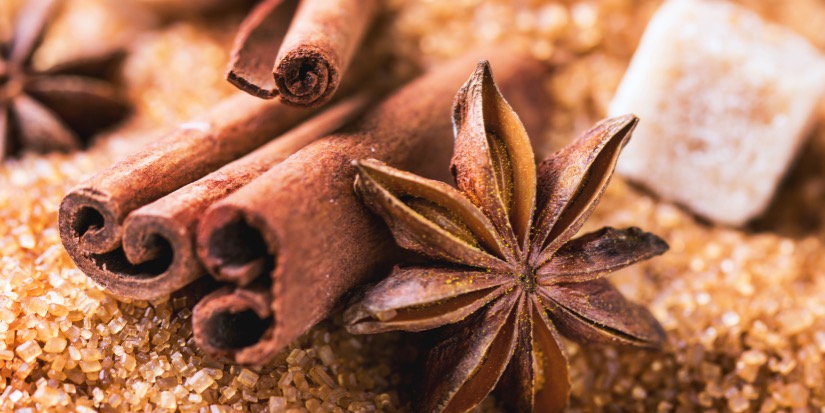Holiday spices are healthy and nice!
- Category: Diabetes and Healthy Eating
- Posted On:

By Jody Long, MS, RDN, CDCES
'Tis the season when it's cold outside and our bodies crave warm foods. It’s also holiday time, which finds us using warming spices, the ones associated with unique aromas and flavors they bring to our food. Several of these are also known for the punch they pack when it comes to imparting health benefits, specifically as good sources of antioxidants.
Antioxidants are well known as cell protectors, limiting damage from free radicals and oxidative stress, and helping in prevention of chronic illness. Cinnamon, nutmeg, ginger, and cloves are a few of the typical holiday spices known not just for their nice flavor and aromas, but for their antioxidant properties, too. Let’s look at what these have to offer.
Cinnamon
Cinnamon stands out as one of the oldest and most widely used spices. It comes from the inner bark of various types of Cinnamomum evergreen trees. It is harvested and dried in the sun, causing it to form curls known as quills (not like porcupines). Although cinnamon bark is most used, the leaves, flowers, fruit, and roots are also used in cooking and for medicinal purposes. Today, cinnamon is often promoted for the health benefits it imparts, and this goes beyond its effect as an antioxidant.
Known best for its anti-inflammatory, antimicrobial, anti-cancer, and anti-diabetic properties, other conditions may also benefit from cinnamon. Lately, there has been a lot of attention to cinnamon and its potential to lower blood sugar. It’s possible that cinnamon might help the body use insulin more effectively; however, there have been inconsistencies in studies involving the different types of cinnamon and doses, which makes comparing results difficult. Also, while small doses and short-term use may be safe, there is the potential for larger quantities taken for longer time frames to cause gastrointestinal problems, allergic reactions, or harm to the liver.
For the time being, the best advice is to consider adding cinnamon in small amounts. Try adding it to beverages, fruit, cereals, smoothies, and sauces or using it in rubs for poultry and meat. I love sprinkling cinnamon on my snack of low-fat cottage cheese and blueberries. Check out the Diabetes Food Hub website for 176 different healthy recipes with cinnamon as an ingredient!

Nutmeg
Nutmeg hails from the Myristica fragrans tree (a type of evergreen tree) that grows in the Banda Islands of Indonesia and the Caribbean Island of Grenada. It is a large seed kernel inside a fruit like an apricot, and housed within a crimson aril, which is also a spice known as mace. It is the dried covering of this kernel that yields the nutmeg spice.
Nutmeg has been popular for many ages in cooking and traditional medicines. The phytonutrients it contains in its oil, Myristica, are associated with health benefits. Some of the noted benefits include helping with indigestion, nausea and diarrhea, enhancing sleep, and improving blood circulation to the brain. A little dose will do, though, as large amounts, suggested to be two tablespoons or more, can cause symptoms such as nausea, dizziness, shock and hallucinations, all signs of nutmeg poisoning.
Nutmeg tastes great as an ingredient in an assortment of baked goods as well as creamy sauces (especially onion-based and milk sauces), soups, stews, marinades, and rubs. I tried the My Plate Beef Stroganoff recipe, which includes nutmeg as an ingredient, and it was a delicious and warming dish.
Ginger
Ginger comes from the root of a perennial herb. Once the plant is grown, the leaves die and the roots are dug up for consumption. Ginger is another popular ingredient in many holiday treat recipes. It is perhaps best known for its taming of tummy troubles, such as indigestion and nausea, and it has a long history of medicinal use that dates back over 2,500 years.
The primary components in ginger believed to offer health benefits are the phenol compounds, gingerol and shogaol. Other helpful constituents include beta-carotene, capsaicin, and curcumin. Besides having great antioxidant benefits, it is also known for benefits including anti-inflammatory, antinausea, and antimicrobial properties. Much more study is needed though to provide confirming evidence. Of note, much of the current research underway is focusing on the impact of ginger's therapeutic agents in cancer treatments.
Ginger can be used as a dried ground spice or purchased as a knobby root and grated fresh. Healthy Eating 101 called this recipe a show stopper: fresh ginger in your sweet potatoes. I plan to serve this for my Christmas dinner, so stay tuned for the feedback!
Cloves
Cloves hail from Indonesia and an evergreen tree (like cinnamon and nutmeg). They are derived from the dried flower buds. Cloves are well known for their antioxidant properties coming from their polyphenolic compounds and convey antimicrobial effects, too. Cloves have a long history of use as a numbing agent and are thought to potentially lower blood sugar. For medicinal purposes, there isn’t enough reliable information regarding appropriate dose levels.
Cloves are often an ingredient in condiments such as ketchup and Worcestershire sauces, and in general, can be incorporated whenever cinnamon and ginger are used. Cooked fruit, baked goods, meat, sauces, rice dishes, and let’s not forget the drinks such as cider or chai! Looking for a midday pick-me-up? Try this Live Simply chai tea latte recipe, it will warm you from your insides out.
So, in addition to your typical antioxidant-rich foods—you know the ones: fresh fruits, vegetables, whole grains, berries, and dark chocolate—consider these spices as part of your antioxidant arsenal in a healthy diet during the holiday season AND beyond!



